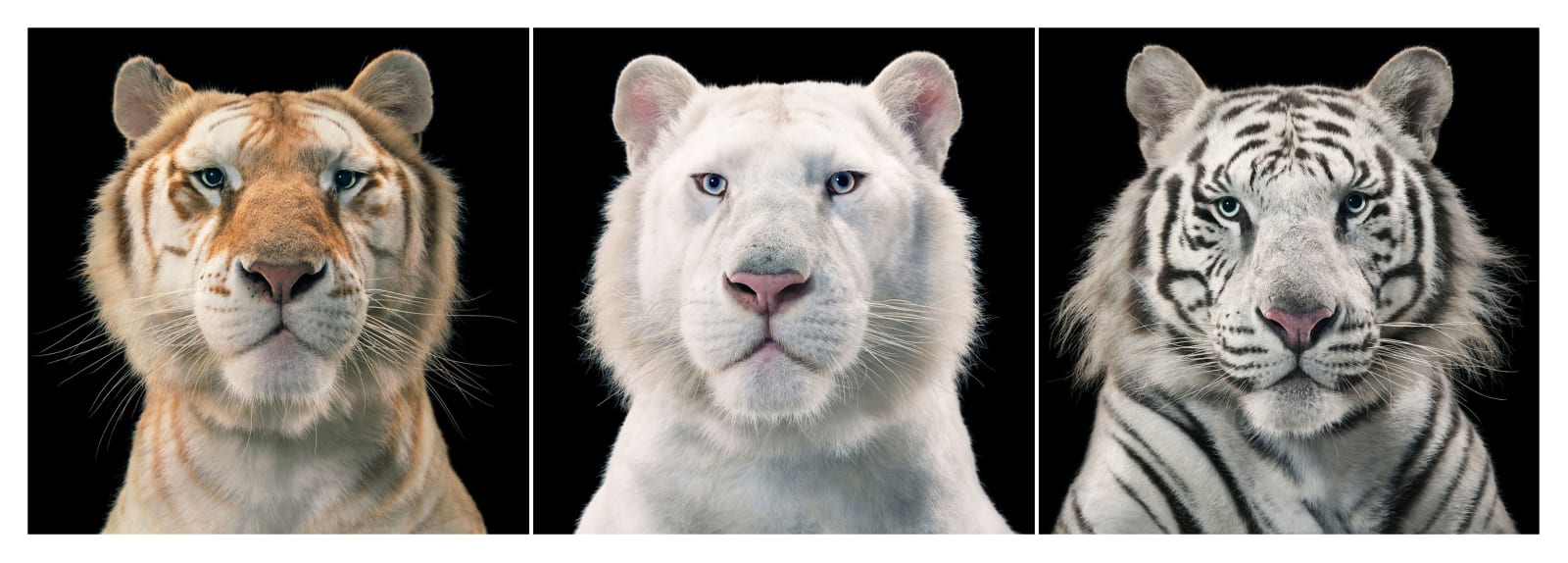FERMÉ du 28 novembre au 13 décembre
Tim Flach Britannique, 1958
Tiger Triptych, 2012
Série: Endangered
Digital C-Print
120 x 360 cm
47 1/4 x 141 3/4 in
(3x) 120 x 120 cm
47 1/4 x 141 3/4 in
(3x) 120 x 120 cm
Edition of 5 plus 5 artist's proofs
71 x 213 cm
28 x 83 7/8 in
(3x) 71 x 71 cm
28 x 83 7/8 in
(3x) 71 x 71 cm
Edition of 10 plus 2 artist's proofs
Plus d'images
(FRANÇAIS CI-DESSOUS) ROYAL WHITE TIGER + SNOW WHITE TIGER Scientific name: Panthera tigris Name: Naryana + Shankar Organization: T.I.G.E.R.S. The Institute of Greatly Endangered and Rare Species, South Caroline, US...
(FRANÇAIS CI-DESSOUS)
__
(FRANÇAIS)
Extrait du livre "More Than Human", Abrams, 2011
ROYAL WHITE TIGER + SNOW WHITE TIGER
Scientific name: Panthera tigris
Name: Naryana + Shankar
Organization: T.I.G.E.R.S. The Institute of Greatly Endangered and Rare Species, South Caroline, US
Keeper: Dr. Bhagavan "Doc" Antle
The overwhelming majority of the captive tiger population has been bred without regulation and has often, as in this case, been used to produce hybrids as theme park attractions. As such hybridization would never naturally occur in the wild, questions must be raised about any possible benefits that this crossbreeding brings. Regulations set by the association of the Zoos and Aquariums in the United States control the separation of closely related species to ensure that hybridization does not occur, but these do not apply to privately owned zoos.
In fact, 80% of the white tigers die because of inbreeding related issues. The 20% remaining suffer from physical issues such as immuno-deficiency, scoliosis, strabismus or mental retardation. Out of the 30 existing white tigers, it is estimated that only one is healthy.
__
(FRANÇAIS)
TIGRE BLANC ROYAL + TIGRE BLANC NEIGE
Scientific name: Panthera tigris
Name: Naryana + Shankar
Organisation: T.I.G.E.R.S. The Institute of Greatly Endangered and Rare Species, South Caroline, US
Gardien: Dr. Bhagavan "Doc" Antle
L’immense majorité de la population de tigres captifs est le résultat d’une reproduction sans regulation et a souvent, comme dans ce cas, été produite pour générer des espèces hybrides recherchées par les parcs d'attraction. Un tel mélange n’aurait jamais eu lieu en milieu naturel. Ce genre de pratique nous porte à nous interroger sur les bénéfices d’un tel élevage. Les règlements instaurés par l’association des zoos et aquariums des États-Unis imposent une stricte séparation entre les espèces génétiquement liées afin d’empêcher de telles mutations. Or, ceux-ci ne s’appliquent pas aux zoos privés.
En fait, 80 % des petits tigres qui naissent blancs meurent à cause d'anomalies dues à la consanguinité. Dans les 20 % restants, beaucoup ont des problèmes physiques comme des déficiences immunitaires, des scolioses, un strabisme élevé ou des troubles mentaux. Les dresseurs de tigres estiment que sur 30 tigres blancs, un seul est réellement en bonne santé.
GOLDEN TABBY TIGER
Scientific name: Panthera tigris
Names: Mutkan
Species: Panthera Tigris
Organization: T.I.G.E.R.S. The Institute of Greatly Endangered and Rare Species, South Caroline, US
Keeper: Dr. Bhagavan "Doc" Antle
The wild population of tigers currently stands at approx. 3,000 (restricted to only 7% of their historical range) and the global captive population stands at approx. 15,000. However, of these, only 1,000 are from registered breeding programs and retain enough genetic viability to be consider candidates to boost wild populations.
The tabby is a deliberately bred variant. It often requires back-crossing - breeding closely related individuals to achieve a physical trait. The coloring is a natural mutation in the wild, but which has also been deliberately bred in zoos and private collections. Eventually, it was realized that this back-crossing and lack of genetic diversity could cause genetic problems, and many zoos have now stopped the practice, although some private zoos continue to perpetuate a tabby variant.
TIGRE DORÉ
Nom latin: Panthera tigris
Nom: Mutkan
Organisation: T.I.G.E.R.S. The Institute of Greatly Endangered and Rare Species, South Caroline, US
Gardien: Dr. Bhagavan "Doc" Antle
La population sauvage de tigres est estimée à environ 3000 individus (soit environ 7% de leur population ancestrale), alors que le nombre de tigres en captivité est de 15 000. Sur ceux-ci, seulement 1000 sont enregistrés au programme d’élevage contrôlé et possèdent encore un patrimoine génétique assez viable pour être considéré comme candidats à la reproduction dans le but d’accroître la population sauvage.
Le tigre doré est une variante créée par l’homme délibérément par retro-croisement qui consiste en le fait de faire se reproduire des individus génétiquement proches afin d’obtenir un trait physique particulier. Cette couleur est aussi une mutation naturelle que l’on peut trouver en milieu naturel mais est le plus souvent le fruit d’un croisement volontaire orchestré par les zoos et les collectionneurs privés. Les conséquences de ces mélanges génétiques fut telles que de nombreux zoos ont cessé cette pratique; les zoos privés eux, perpétuent ces variantes.
Extrait du livre "More Than Human", Abrams, 2011











